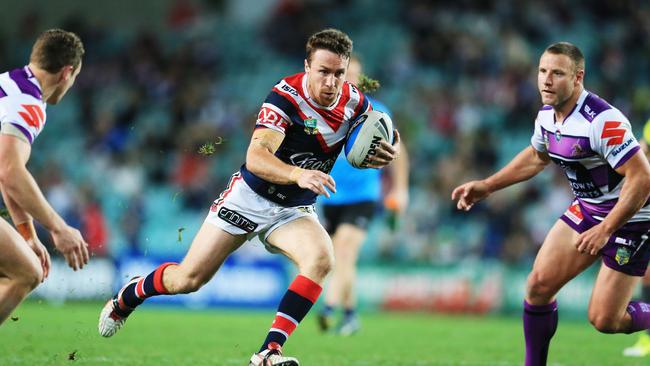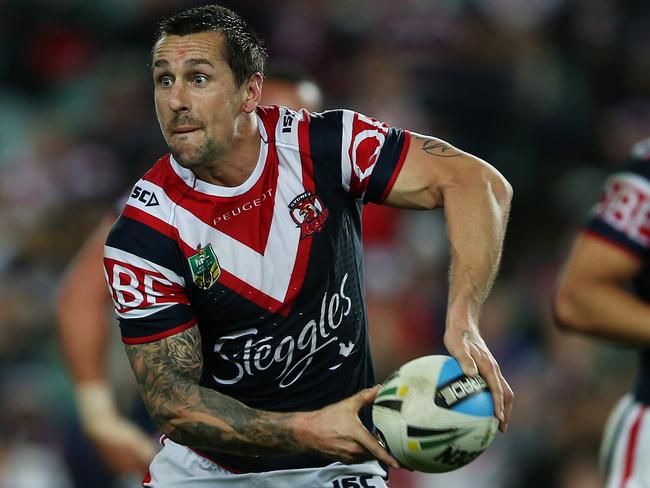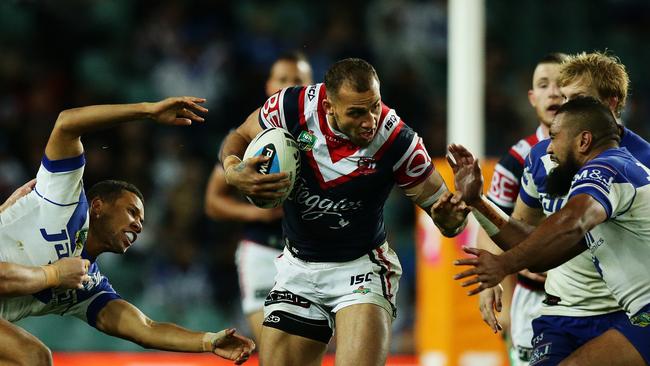Blake Ferguson, Mitchell Pearce and Jackson Hastings the keys for the Roosters in 2016
THE Roosters will be aiming for their fourth minor premiership in a row in 2016, but they have a couple of problems to solve first, writes NICK CAMPTON.

Roosters
Don't miss out on the headlines from Roosters. Followed categories will be added to My News.
CONVENTIONAL wisdom says that the halves are the most important players in a rugby league team. This is still true, but not quite as much as it once was.
So long as halves control the organisation of a team and undertake the majority of the kicking they’ll always be among the top dogs, but fullbacks have reached a point where they are just as integral to a team’s title ambitions.
The No. 1s need the speed and athleticism to operate as a dangerous runner all over the park, the nous and skill to act as a secondary playmaker and the durability and fitness to return kicks and make yards over and over and over again.
They also need to fly up the middle of the field whenever there’s a break, they need to organise the defensive line, they need to be able to diffuse kicks of all types and they need to be urgent enough to get to those kicks as soon as humanly possible.
Most clubs have to settle for a fullback that can do the majority of those things, because finding a total package is so rare that there’s only a handful of players in the game who truly can do it all.
Former Rooster and incoming Warrior Roger Tuivasa-Sheck is one of those players.
In 2015, his first full season as a fullback, Tuivasa-Sheck was out of this world. He was second in the NRL for tackle busts with 148, he ran for a record-smashing 5795 metres, he scored 12 tries and set up 16 more and had 21 linebreaks and 18 line break assists.
It was his first year in a new position and he put together a season that any fullback in NRL history would be proud to call their own. Roger Tuivasa-Sheck is the sort of player you build a premiership around, but he’s not at Bondi anymore. This is a problem.
The loss of Tuivasa-Sheck is compounded by the loss of Maloney, who was surprisingly allowed to leave the club for Cronulla with much more of a whimper than a bang.
Considering how important Maloney has been to the Roosters since he joined the club in 2013, this comes across as unbelievable. He has been the lynchpin and the creative fulcrum for the team for the past three seasons, leading or co-leading the side in try assists in all three years, leading the team in line break assists twice and surpassing Mitchell Pearce each season in terms of line breaks and two out of three years with tackle busts.
Throw in his excellent general kicking game and goal-kicking and he’s one of the better halves money can buy, but he’s not at Bondi anymore. This is another problem.
Roster management is often an exercise in problem solving — injuries, retirements or departures create gaps, which need to be filled — and how the Roosters solve these problems could not only decide their fate for 2016, it could set them on a certain path for several seasons to come.
The solution for Maloney’s departure is simple, with the club certain to slot in impressive youngster Jackson Hastings. Earmarked as a potential star for several seasons, Hastings has played 19 first-grade matches in since 2014, with 13 coming off the bench and six in relief of Mitchell Pearce due to Origin or injury.

While the sample size was small, the signs were also quite promising. Hastings’ job was to not rock the boat, to compliment Maloney as best he could and to chip in wherever he could with his kicking game. He performed this role competently and the results spoke for themselves — the Roosters’ sole defeat with Hastings at halfback last season was their 20-18 loss to Melbourne in the first week of the finals.
However, now that Maloney has departed Hastings’ role is going to change as partnering Pearce is an entirely different proposition. Make no mistake, Maloney has been the dominant partner in the halves for the Roosters since he arrived at the club. He is a naturally dominant player and it allowed Pearce to settle in as a secondary playmaker, which eased the pressure on the much-maligned halfback and simplified his role. The result meant Pearce was able to thrive, producing three of the best seasons of his career.
It stands to reason that Hastings’ role in the team will not change — he’s still only 20 and only has six first-grade matches in the halves to his name — so Pearce will be forced to shoulder a greater burden than before. Can Pearce function as the dominant playmaker and provide the same mix of organisational skills and attacking spark as Maloney?

This is an impossible question to definitively answer, because Pearce has never had to be the senior partner or the dominant force for the Roosters. In his formative years (2007-09) he was paired with Braith Anasta, followed by his season with Carney (2010-11), another season and a half with Anasta (2011-12) before Maloney came to town.
Pearce’s maligned Origin record can blind some to his sustained form at club level. He’s topped 20 try assists each season from 2010 onwards and currently has the fourth most try assists of any active player and the eighth most since 2000. He’s a very good halfback at club level when he’s used in a certain way. However, he’ll be asked to do more than he’s done before in 2016 and the Roosters’ premiership hopes will rest heavily on him.

The club’s plans for fullback are much murkier and full of positive and negative possibilities. Blake Ferguson seems to be in the box seat to replace Tuivasa-Sheck, a positional switch could either be sublime or horrendous, with little room in-between. Of the varied skills a fullback needs, the ones we mentioned earlier, Ferguson has some of them in spades but barely possess the others at all.
He’s an incredible athlete who would be dangerous in the open field and would be a nightmare in broken field situations, especially when he’s given space with kick returns. The proposition of getting him involved all over the field instead of nailing him to one side as a centre is undeniably intriguing.
However, does Ferguson possess the tactical nous, the footballing intelligence to play fullback? He is a hurricane of a player who can blow through a team and leave nothing but embarrassed defenders in his wake, but he’s also loose with his hands and is yet to show any real talent as a ball-player. In his 151 first grade matches he’s put together a grand total of 14 try assists. It could be that he’s got wonderful instincts for ball movement and the deft touch required to unleash his outside men, but the fact of the matter is that we don’t know because he’s never been asked to use those skills on a consistent basis.
From an errors standpoint, Ferguson can drop a ball with the best of them — he made 34 errors in 2015, the eighth most in the league, despite playing just 19 matches. In 2012, the best full season he’s played in first grade, he made a whopping 44 errors in 25 matches. As a centre he’s worth it because he’s so deadly with the ball but a move to fullback means he’ll get more touches and with more touches more errors may follow.
Ferguson already has two matches at fullback to his name, back in 2011, and neither were what you’d call a success. In Round 5 and Round 6 of that season, Ferguson slotted into the back for Canberra and across the two matches he recorded two tries, one try assist, 324 run metres, seven tackle busts and five errors.
In a vacuum, those numbers are perfectly adequate (except for the five errors) but in the two matches Ferguson looked uncomfortable in the role and the two tries he did score were more down to his own power as a runner than anything else. Having said that, we need to take those two matches with a significant grain of salt — Ferguson was a younger and inarguably less effective player at the time.
Pitching him into the role for a couple of weeks is one thing, having him undertake an entire off-season before assuming the position full-time is quite another.

The concerns around Ferguson’s ball-playing are just one of several issues surrounding his potential switch. How is his positional play? Can he organise the defence? Offensively he’s superb under the high ball, but what about defensively? Will he strike up a combination with his halves?
Even the best-case scenario for Ferguson at fullback means he’ll only be a short-term solution. Latrell Mitchell, a rangy product from Taree, has been compared to Greg Inglis and will more likely than not be given a few matches on the wing with a view to him being the club’s long-term fullback.
The spectre of Jarryd Hayne also looms large over the Tricolours with the Roosters favoured to land the two-time Dally M winner should he call an end to his NFL career.
Even if Ferguson is a success at fullback, issues cloud his long-term future at the position.
In a measure of both the quality of the Roosters’ roster and the coaching abilities of Trent Robinson, if they can solve their two problems they’ll be contenders for a fourth minor premiership in a row and could capture their second premiership since 2013.
The possible departure of Michael Jennings notwithstanding, they still have a razor sharp backline and a fearsome forward pack capable of rolling over almost every team in the competition.
They have just two questions hanging over their squad, two problems they need to solve. It just so happens that the two problems involve the two most important positions on the field.
Originally published as Blake Ferguson, Mitchell Pearce and Jackson Hastings the keys for the Roosters in 2016




